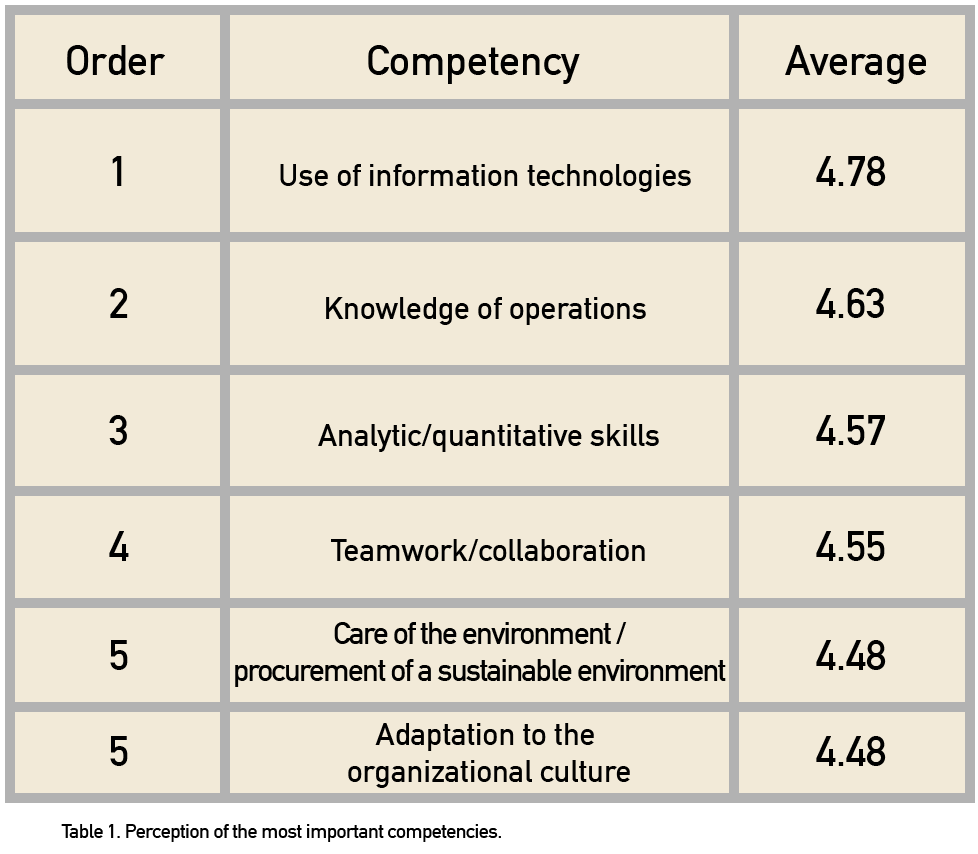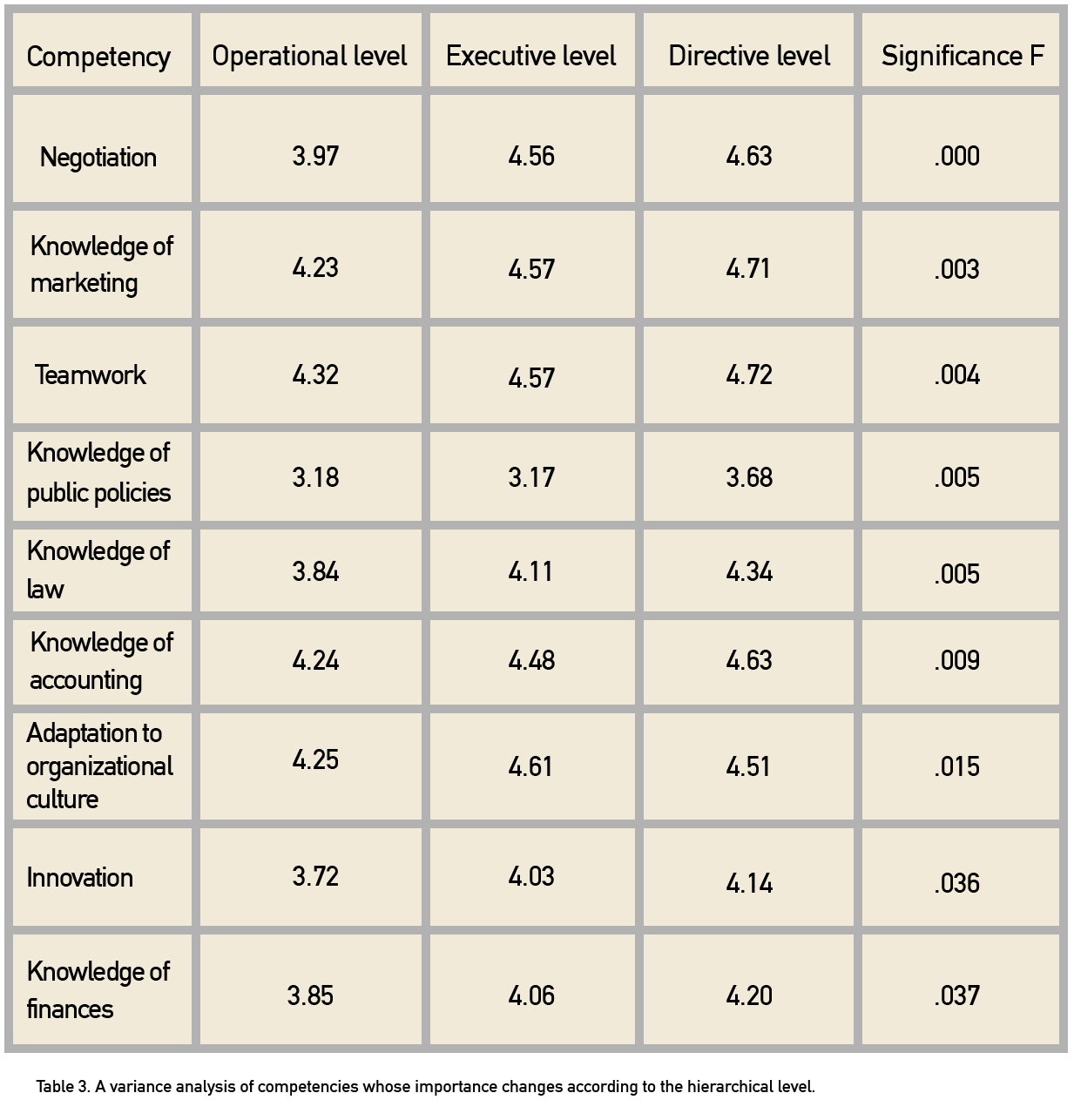The Importance of Managerial Competencies in Different Hierarchical Levels of Mexican Organizations
Posted By pfabre On 9 May, 2017 @ 1:22 pm In Edición 60,Strategy,Current Issue | No Comments
 [1]By: Carlos Alcérreca J. and Aurora Monroy.
[1]By: Carlos Alcérreca J. and Aurora Monroy.
Introduction
In this article we try to identify the managerial competencies that are important in Mexican organizations and to assess whether these competencies differ in accordance with the hierarchical level of the people. A competency is defined here as a mixture of the knowledge and skills necessary to perform the functions of a job in the organization. The concept of managerial competencies focuses attention on what people are able or required to do to perform their work. The studies listed in the bibliography on this topic were conducted mainly in the United States ((Dai, Tang and De Meuse, 2011; Kaiser, Craig, Overfield and Yarborough, 2011; Mumford, Campion and Morgeson, 2003; De Meuse, Dai and Wu, 2011).
This study may be useful for organizations, universities and career planners. For organizations, the study can provide insights on qualities to be evaluated when considering candidates for positions, especially when the promotion of a person to a new hierarchical level is involved. It could also be used as a framework for evaluating staff performance in their current positions. In addition, it is possible to use this information in establishing the objectives of training and development programs. For universities, the framework would serve to establish learning objectives and to update the curricula of private and public administration academic programs. Finally, budding executives can use the competency framework to plan their personal development. This last perspective is the one that will be addressed in this article.
Methodology
First, a list of competencies was selected from the specialized bibliography. In particular the studies conducted by The Conference Board, The American Management Association and The Wall Street Journal were taken into account. The competencies that were used more frequently were considered in this study. The knowledge in two areas was added to this list. First, basic areas related to business, such as economics, law, public policies and quantitative methods. Then, knowledge in functions of administration, such as knowledge of marketing, finance, accounting, operations and human resources were also included. A final list of 30 competencies was obtained.
Next, a question was designed: “According to your experience and using a scale from 1 to 5, where 1 means ‘not very important’ and 5 ‘very important,’ how important has each of (the competencies) been in the position you currently occupy in your organization?”
In the questionnaire, the respondent was asked to indicate his/her hierarchical level in the organization according to three levels:
-
Directive level: General manager, CEO, CFO, etc.
-
Executive level: Area manager or director
-
Operational level: In charge of no personnel
The questionnaire was sent in 2016 to 6,306 graduates of business programs of a private, non-profit university in Mexico City. The programs were undergraduate, diplomado (specialization courses) and master’s level. We obtained 645 responses that were reviewed and validated, and a final database was compiled with the responses of 348 people, which represented a 5.52% final response rate.
An Analysis of Variance statistical technique was used with the data to determine if people at different hierarchical levels had different perceptions of the importance of each competency.
Results
63% of the respondents were men and 37% were women. Of the total, 19% were in the operational level, 48% in the executive and 33% in the directive level. The average age of the respondents was 42 years, with a standard deviation of 13 years. Regarding the educational level, 57% had a bachelor’s degree, 41% a master’s degree and 2% a Ph.D. In their areas of work, 27% worked in finance, 15% in general management, 12% in marketing and sales, 11% in accounting, auditing and taxes, 8% in operations and purchases, 4% in consulting, 4% in human resources and 19% in other departments.
The average importance attributed to a competency was 4.2. The competencies perceived as of greatest importance in their current position were: use of information technologies, knowledge of operations, analytic/quantitative skills, teamwork/collaboration, care of the environment/procurement of a sustainable environment and adaptation to the organizational culture (Table 1).
Table 1. Perception of the most important competencies.
The competencies perceived as of lesser importance in the current position of the person were: knowledge of public policies, knowledge of economics, strategic thinking, creativity, written communication and global perspective (Table 2).
Table 2. Perception of competencies of lesser importance.
Significant differences were detected in the importance attributed to the competencies at the different hierarchical levels, indicating that the importance of certain competencies increases with the hierarchical level of the person. The most significant differences, from a statistical point of view, were in negotiation skills, knowledge of marketing, teamwork/collaboration, knowledge of public policies, knowledge of law, knowledge of accounting, adaptation to the organizational culture, innovation and knowledge of finance. (Table 3).
Table 3. A variance analysis of competencies whose importance changes according to the hierarchical level.
Discussion
First, the competencies perceived as the most important, especially the importance given to information technologies, confirm that we are well advanced in the third industrial revolution, of digital and information technologies, and that this requires expertise in this area to perform properly in the world of work. The problem of preparing oneself in this area is that it changes very quickly and it is very specific to each organization, which can use different systems and software.
The importance given to the knowledge of operations indicates that the majority of people who work are dedicated to “operating” an existing process or system. Therefore, it is necessary to prepare oneself by learning about process management. Analytical skills are also important because in many positions, for example in the field of finance and consulting, various aspects of reality are analyzed. Teamwork is essential for process operations and the realization of projects in organizations. Care of the environment is present every day in the media, there is legislation on the subject, and it is crucial for our civilization.
The adaptation to the organizational culture is underestimated in the preparation of the people, but it is critical in order to be successful in organizations, especially for those who have the intention of ascending in the organizational hierarchy. This theme is emphasized in the induction programs of companies, but only over time will people come to understand the culture of the organization. Those who fail to adapt to the culture do not advance and often end up leaving the organization.
Secondly, it must be taken into consideration that this is a study of the 30 competencies that had been identified as important in previous studies, and minor competencies were not included. Therefore, the competencies that appear here as of lesser importance should not be considered irrelevant or that it is not worth the effort to cultivate them. The one that appears in the last place, knowledge of public policies, is a competency that increases in importance with the hierarchical level. However, for those who responded, information technologies, operations and analytical skills were considered more important than public policies, economics, strategic thinking and creativity, indicating that, during that at the time, the concern of most people was operating a process or system rather than changing it.
Finally, significant differences were detected in the importance attributed to different competencies by hierarchical level. These competencies, whose importance increases with the hierarchical level, are: negotiation, teamwork, innovation, adaption to the organizational culture, knowledge of marketing, accounting and finance, knowledge of public policies and law.
These competencies can be grouped together to form a conceptual framework integrated by four dilemmas: the dilemma of relationships, the dilemma of change, the functional dilemma and the dilemma of the structure of the environment or institutions.
The dilemma of relationships is the space negotiation-teamwork/collaboration. In this space, before a situation or project in which one must relate to others, a person could consider the problem as one of allocation of resources and seek to negotiate, thus competing for a part of the resources at stake, or one of creating more value seeking to collaborate and cooperate to increase the value of the resources for all participants. The resulting behavior, the mixture of negotiation and collaboration, has four possible profiles: low in negotiation and collaboration, high in negotiation and low in collaboration, low in negotiation and high in collaboration, and high in negotiation and collaboration. When moving to a higher hierarchical level, people must change their competencies so that their profile is increasingly higher both in negotiation and in collaboration. That is, they have to focus on both the creation and allocation of resources.
The dilemma of change is the space innovation-adaptation to the organizational culture. The person may face situations with the idea of adapting or innovating. This leads to four potential profiles for change: low in adaptation and innovation, high in adaptation and low in innovation, low in adaptation and high in innovation, and high in adaptation and innovation. When promoted to higher levels of the hierarchy, people must acquire competencies that provide adaptability and innovation. That is, they need to be “ambidextrous” in their relation to change.
The functional dilemma is the marketing-finance and accounting space and it focuses on the question for whom is the value created. In this space, marketing represents an orientation toward the markets of clients and finance and accounting are inclined toward the financial markets. People with a high or low profile can be identified in each one of these orientations. However, at high hierarchical levels it is necessary to know and conciliate the orientation to marketing with the orientation to finance and accounting.
The institutional, or structure of the environment, dilemma is the space of law-public policies and represents the opportunities and constraints of the environment. In this space, law represents the institutional normativity and the public policies, the discretion of the political leaders. Different profiles of people may have high or low knowledge in each of these areas. However, in high hierarchical levels one must know the two areas.
Conclusion
In general, business program graduates are more involved in the operation and analysis of administrative processes and systems (using information technologies) than in their strategic change. Surely, the operation consumes most of the time of the executives. However, when promoted to a new hierarchical level, they need to reinforce knowledge and skills that they previously considered to be of lesser importance. To do this, they need to acquire competencies that can be conceptualized as dilemmas in relationships, change, functional areas and the structure of the environment in which they operate. People seeking to develop their careers must be prepared in these areas if they are to succeed at the highest hierarchical levels of organizations.
References
- American Management Association, AMA 2010 Critical Skills Survey, April 15, 2010.
- The Conference Board, Developing Business Leaders for 2010. Executive Summary. April 2002. Report R-1315-02-RR.
- Davidson, Kate, The ‘Soft Skills’ Employers Are Looking For, The Wall Street Journal, August 30, 2016.
- Day, G., Tang, K.Y. and De Meuse, K.P., Leadership Competencies Across Organizational Levels: A Test of the Pipeline Model, Journal of Management Development, Vol. 30, No. 4, pp. 366-380, 2011.
- De Meuse, K.P. Dai, G. and Wu, J. Leadership Skills Across Organizational Levels: A Closer Examination, The Psychologist-Manager Journal, 14:130-139, 2011.
- The Wall Street Journal, How the Rankings Were Compiled, September 30, 2010.
- Kaiser, R.B. and Craig, S. B. Do the Behaviors Related to Managerial Effectiveness Really Change with Organizational Level? An Empirical Test, The Psychologist-Manager Journal, 14: 92-119, 2011.
- Kaiser, R.B., Craig, S.B., Overfield, D.V. and Yarborough, P., Differences in Managerial Jobs at the Bottom, Middle and Top: A Review of the Empirical Research, The Psychologist-Manager Journal, 14:76-91, 2011.
- Mumford, T.V., Campion, M.A. and Morgeson, F.P., The Leadership Skills Strataplex: Leadership Skill Requirements Across Organizational Levels, Academy of Management Best Conference Paper 2003.
Article printed from Dirección Estratégica: http://direccionestrategica.itam.mx
URL to article: http://direccionestrategica.itam.mx/la-importancia-de-las-competencias-gerenciales-en-distintos-niveles-jerarquicos-de-las-organizaciones-mexicanas/
URLs in this post:
[1] Image: http://direccionestrategica.itam.mx/wp-content/uploads/2017/05/Competencias-gerenciales.jpg
[2] Image: http://direccionestrategica.itam.mx/wp-content/uploads/2017/05/Competencias-Gerenciales_tabla-1_ing.png
[3] Image: http://direccionestrategica.itam.mx/wp-content/uploads/2017/05/Competencias-Gerenciales_tabla-2_ing.png
[4] Image: http://direccionestrategica.itam.mx/wp-content/uploads/2017/05/Competencias-Gerenciales_tabla-3_ing.png


